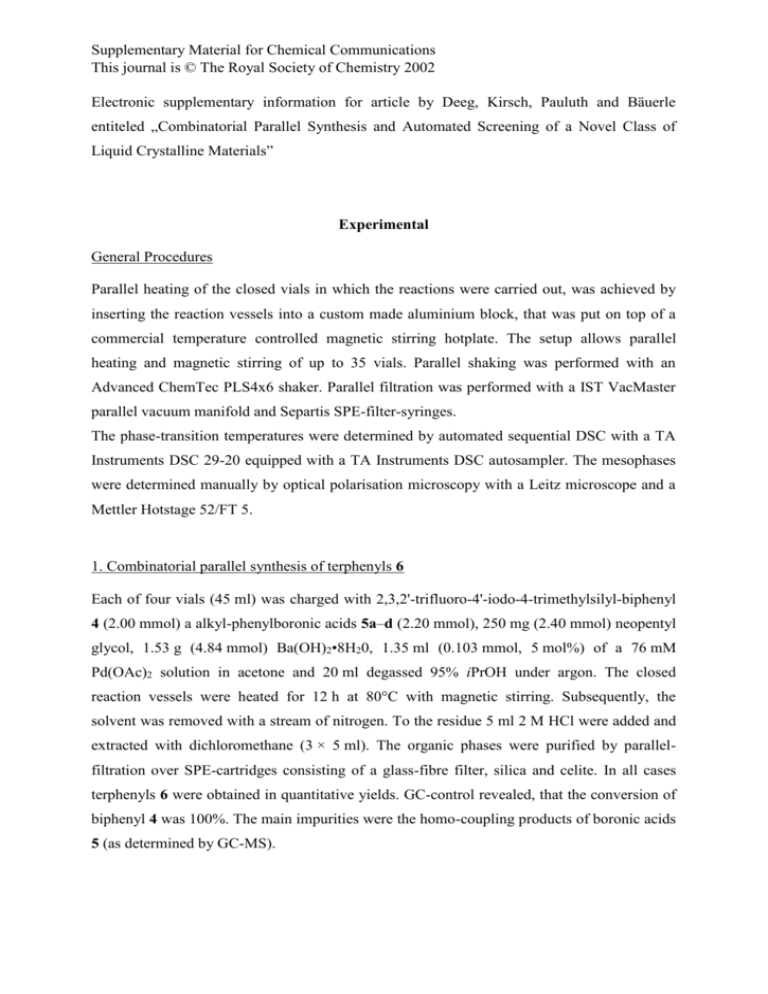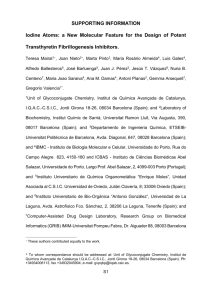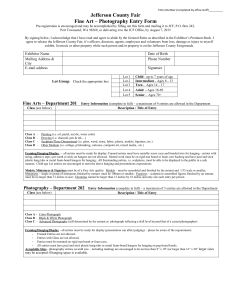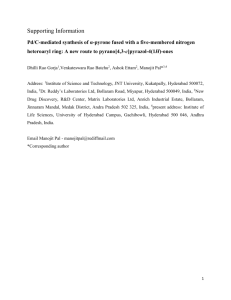Combinatorial Parallel Synthesis and Automated Screening of a
advertisement

Supplementary Material for Chemical Communications This journal is © The Royal Society of Chemistry 2002 Electronic supplementary information for article by Deeg, Kirsch, Pauluth and Bäuerle entiteled „Combinatorial Parallel Synthesis and Automated Screening of a Novel Class of Liquid Crystalline Materials” Experimental General Procedures Parallel heating of the closed vials in which the reactions were carried out, was achieved by inserting the reaction vessels into a custom made aluminium block, that was put on top of a commercial temperature controlled magnetic stirring hotplate. The setup allows parallel heating and magnetic stirring of up to 35 vials. Parallel shaking was performed with an Advanced ChemTec PLS4x6 shaker. Parallel filtration was performed with a IST VacMaster parallel vacuum manifold and Separtis SPE-filter-syringes. The phase-transition temperatures were determined by automated sequential DSC with a TA Instruments DSC 29-20 equipped with a TA Instruments DSC autosampler. The mesophases were determined manually by optical polarisation microscopy with a Leitz microscope and a Mettler Hotstage 52/FT 5. 1. Combinatorial parallel synthesis of terphenyls 6 Each of four vials (45 ml) was charged with 2,3,2'-trifluoro-4'-iodo-4-trimethylsilyl-biphenyl 4 (2.00 mmol) a alkyl-phenylboronic acids 5a–d (2.20 mmol), 250 mg (2.40 mmol) neopentyl glycol, 1.53 g (4.84 mmol) Ba(OH)2•8H20, 1.35 ml (0.103 mmol, 5 mol%) of a 76 mM Pd(OAc)2 solution in acetone and 20 ml degassed 95% iPrOH under argon. The closed reaction vessels were heated for 12 h at 80°C with magnetic stirring. Subsequently, the solvent was removed with a stream of nitrogen. To the residue 5 ml 2 M HCl were added and extracted with dichloromethane (3 × 5 ml). The organic phases were purified by parallelfiltration over SPE-cartridges consisting of a glass-fibre filter, silica and celite. In all cases terphenyls 6 were obtained in quantitative yields. GC-control revealed, that the conversion of biphenyl 4 was 100%. The main impurities were the homo-coupling products of boronic acids 5 (as determined by GC-MS). Supplementary Material for Chemical Communications This journal is © The Royal Society of Chemistry 2002 Table 1: Yield and purity of terphenyls 6 F F 6a, R = pr 6b, R = tbu 6c, R = pent 6d, R = dec F R Si entry product R conversion of 4[a] [%] purity[a] [%] 1 6a propyl quant. 89 2 6b tbutyl quant. 70 3 6c pentyl quant. 66 4 6d decyl quant. 75 [a] as determined by GC 2. Parallel iodo-desilylation of terphenyls 6 The crude terphenyls 6 were dissolved in 4 ml abs. acetonitrile and reacted in parallel in four 10 ml syringes equipped with a PE-frit by adding 1.20 ml (6.00 mmol) of a 5 M solution of ICl in MeCN and shaking for 1 h at RT. The precipitated product 7 was filtered off by application of vacuum and washed 2 M Na2S2O5 (10 ml) and water (10 ml) and dried in vacuo. Table 2: Yield and purity of terphenyls 7 7a, R = pr 7b, R = tbu 7c, R = pent 7d, R = dec F F R F I entry product R yield[a],[b] [%] purity[c] [%] 1 7a propyl 54 95 2 7b tbutyl 58 82 3 7c pentyl 49 91 4 7d decyl 45 95 [a] determined by balancing; [b] two steps form biphenyl 4; [c] determined by GC 3. Combinatorial parallel synthesis of quaterphenyls 8 Each of 16 vials (7 ml) was charged with a terphenyl 7a–d (0.100 mmol), an alkylphenylboronic acid 5a–d (0.120 mmol) and 13.6 mg (0.13 mmol) neopentyl glycol, 95.0 mg (0.301 mmol) Ba(OH)2•8H20, 80 l (6.08 mmol, 5 mol%) of a 76 mM solution of Pd(OAc)2 in acetone and 2 ml degassed 95% iPrOH under argon. The closed reaction vessels were heated for 12 h at 80°C with magnetic stirring. Subsequently, the solvent was removed with a Supplementary Material for Chemical Communications This journal is © The Royal Society of Chemistry 2002 stream of nitrogen. To the residue 2 ml 2 M HCl were added and extracted with dichloromethane (3 × 2 ml). The organic phases were purified by parallel-filtration over SPEcartridges consisting of a glass-fibre filter, silica and celite. The crude products 8 were recrystallised twice from nonane. The phase-transition temperatures were determined by automated sequential DSC with a TA Instruments DSC 29-20 equipped with a TA Instruments DSC autosampler. Mesophases were determined by optical polarisation microscopy with a Leitz microscope and a Mettler Hotstage 52/FT 5. Table 3: Yield and purity of quaterphenyls 8 F F F R´ R 8aa-dd entry product R R' yield[a] [%] purity[b] [%] phase-transition temperatures [°C] Hmelt [kcal/mol] 1 8aa propyl propyl 61 > 99 % K 150 (S? 137) N 267.7 I 6.8 2 8ab propyl tbutyl 76 > 99 % K 140 N 153.0 I 6.6 3 8ac propyl pentyl 42 > 99 % K 103 N 252.5 I 3.4 4 8ad propyl decyl 55 > 99 % K 103 SC 114 N 205.1 I 8.5 5 8ba tbutyl propyl 30 > 99 % K 171 (N 150.8) I 8.9 6 8bb tbutyl tbutyl 57 > 99 % K 177 S? 227.0 I 5.2 7 8bc tbutyl pentyl 54 > 99 % K 134 N 144.3 I 8.7 8 8bd tbutyl decyl 55 > 99 % K 101 SC 123 N 127.5 I 7.5 9 8ca pentyl propyl 53 > 99 % K 99 N 250.6 I 6.1 10 8cb pentyl tbutyl 75 > 99 % K 133 N 140.8 I 7.0 11 8cc pentyl pentyl 56 > 99 % K 106 N 234.4 I 6.1 12 8cd pentyl decyl 49 > 99 % K 102 SC 135 N 197.5 I 9.1 13 8da decyl propyl 65 > 99 % K 93 N 207.9 I 6.5 14 8db decyl tbutyl 60 > 99 % K 115 N 119.3 I 4.5 15 8dc decyl pentyl 61 > 99 % K 85 S? ? N 198.7 I 9.0 16 8dd decyl decyl 73 > 99 % K 104 SC 158 N 177.3 I [a] determined by balancing; [b] HPLC 12.0 Supplementary Material for Chemical Communications This journal is © The Royal Society of Chemistry 2002 NMR-spectroscopic characterisation of selected library-members 2',3',2''-Trifluoro-4,4'''-dipropyl-[1,4':1',1'':4'',1''']quaterphenyl 8aa F F 1H-NMR F (400.1 MHz, CDCl3): = 1.007 (t, JHH = 7.3 Hz, 3 H), 1.013 (t, JHH = 7.3 Hz, 3 H), 1.72 (sex, JHH = 7.5 Hz, 2 H), 1.73 (sex, JHH = 7.5 Hz, 2 H), 2.67 (t, JHH = 7.6 Hz, 2 H), 2.68 (t, JHH = 7.5 Hz, 2 H), 7.23–7.32 (m, 6 H), 7.43–7.58 (m, 7 H). 13C-NMR (100.6 MHz, CDCl3): = 13.84, 13.87, 24.4, 24.5, 37.7, 37.8, 114.2 (d, JCF = 23.2 Hz), 120.8 (dd, JCF = 15.2 Hz, JCF = 2.3 Hz), 122.6 (d, JCF = 3.4 Hz), 123.8 (d, JCF = 12.5 Hz), 124.5 (t, JCF = 3.4 Hz), 125.6 (br. s), 126.9, 128.74, 128.76, 129.1, 130.7 (d, JCF = 10.6 Hz), 131.6 (br. s), 131.9, 136.7 (d, JCF = 1.9 Hz), 142.9 (d, JCF = 12.9 Hz), 143.6 (d, JCF = 8.4 Hz), 148.3 (dd, JCF = 249.6 Hz, JCF = 13.9 Hz), 148.7 (dd, JCF = 250.1 Hz, JCF = 14.4 Hz), 160.0 (d, JCF = 249.4 Hz). The increased intensity at = 128.8 indicates, that two carbon resonances coincide here. MS (APCI+, CH2Cl2, hexane): m/z = 445.5 [M+H]+. 2',3',2''-Trifluoro-4'''-pentyl-4-propyl-[1,4':1',1'':4'',1''']quaterphenyl 8ca C5H11 F F 1H-NMR F (400.1 MHz, CDCl3): = 0.92 (t, JHH = 6.7 Hz, 3 H), 1.00 (t, JHH = 7.3 Hz, 3 H), 1.35–1.38 (m, 4 H), 1.65–1.75 (m, 4 H), 2.65–2.67 (m, 4 H), 7.23–7.31 (m, 6 H), 7.42–7.57 (m, 7 H). 13C-NMR (100.6 MHz, CDCl3): = 13.9, 14.0, 22.5, 24.4, 31.1, 31.5, 35.6, 37.8 114.2 (d, JCF = 22.9 Hz), 120.7 (d, JCF = 13.8 Hz), 122.6 (d, JCF = 2.9 Hz), 123.9 (d, JCF = 12.4 Hz), 124.5, 125.6 (br. s), 126.9, 128.8, 129.0, 130.7 (d, JCF = 10.5 Hz), 131.6 (br. s), 131.9, 136.7, 143.1 (d, JCF = 18.1 Hz), 143.7 (d, JCF = 8.1 Hz), 148.4 (dd, JCF = 255.6 Hz, JCF = 14.8 Hz), 148.7 (dd, JCF = 250.6 Hz, JCF = 13.6 Hz), 160.1 (d, JCF = 248.9 Hz). The increased intensities at = 128.8 and 129.0 indicate, that two carbon resonances coincide here. Supplementary Material for Chemical Communications This journal is © The Royal Society of Chemistry 2002 4-Decyl-2',3',2''-trifluoro-4'''-propyl-[1,4':1',1'':4'',1''']quaterphenyl 8ad C10 H21 F F 1H-NMR F (400.1 MHz, CDCl3): = 0.90 (t, JHH = 6.9 Hz, 3 H), 1.00 (t, JHH = 7.3 Hz, 3 H), 1.26–1.40 (m, 14 H), 1.69 (sex, JHH = 7.5 Hz, 2 H), 1.71 (sex, JHH = 7.5 Hz, 2 H), 2.66 (t, JHH = 7.5 Hz, 2 H), 2.68 (t, JHH = 7.5 Hz, 2 H), 7.23–7.32 (m, 6 H), 7.42–7.57 (m, 7 H). 13C-NMR (100.6 MHz, CDCl3): = 13.8, 14.1, 22.7, 24.5, 29.3, 29.4, 29.5, 29.60, 29.63, 31.4, 31.9, 35.7, 37.7, 114.2 (d, JCF = 23.2 Hz), 120.8 (dd, JCF = 15.6 Hz, JCF = 2.3 Hz), 122.6 (d, JCF = 3.0 Hz), 123.8 (d, JCF = 12.9 Hz), 124.5 (t, JCF = 3.4 Hz), 125.6, 126.9, 128.7, 128.8 (d, JCF = 3.0 Hz), 129.1, 130.7 (d, JCF = 10.6 Hz), 131.6 (br. s), 131.9 (br. s), 136.7 (d, JCF = 1.9 Hz), 142.9, 143.3, 143.6 (d, JCF = 8.0 Hz), 148.3 (dd, JCF = 249.6 Hz, JCF = 13.9 Hz), 148.7 (dd, JCF = 250.3 Hz, JCF = 13.9 Hz), 160.1 (d, JCF = 249.0 Hz). 4,4'''-Bis-decyl-2',3',2''-trifluoro-[1,4':1',1'':4'',1''']quaterphenyl 8dd C10 H21 C10 H21 F F 1H-NMR F (400.1 MHz, CDCl3): = 0.88–0.92 (m, 6 H), 1.24–1.42 (m, 28 H), 1.64–1.72 (m, 4 H), 2.66–2.70 (m, 4 H), 7.23–7.32 (m, 6 H), 7.42–7.57 (m, 7 H). 13C-NMR (100.6 MHz, CDCl3): = 14.1, 22.7, 29.34, 29.37, 29.39, 29.5, 29.60, 29.64, 31.39, 31.43, 31.9, 35.7, 35.8, 114.2 (d, JCF = 23.2 Hz), 120.8 (dd, JCF = 15.6 Hz, JCF = 2.3 Hz), 122.6 (d, JCF = 3.0 Hz), 123.8 (d, JCF = 12.5 Hz), 124.5 (t, JCF = 3.4 Hz), 125.6, 126.9, 128.7, 128.8 (d, JCF = 3.0 Hz), 129.0, 130.7 (d, JCF = 10.6 Hz), 131.6 (dd, JCF = 3.4 Hz, JCF = 2.3 Hz), 131.9 (br. s), 136.7 (d, JCF = 1.9 Hz), 143.1, 143.3, 143.7 (d, JCF = 8.0 Hz), 148.3 (dd, JCF = 249.6 Hz, JCF = 13.9 Hz), 148.7 (dd, JCF = 250.5 Hz, JCF = 14.0 Hz), 160.1 (d, JCF = 249.0 Hz). The increased intensities at = 14.1, 22.7, 29.34, 29.5, 29.60, 29.64, and 31.9 indicate, that two carbon resonances coincide here.






